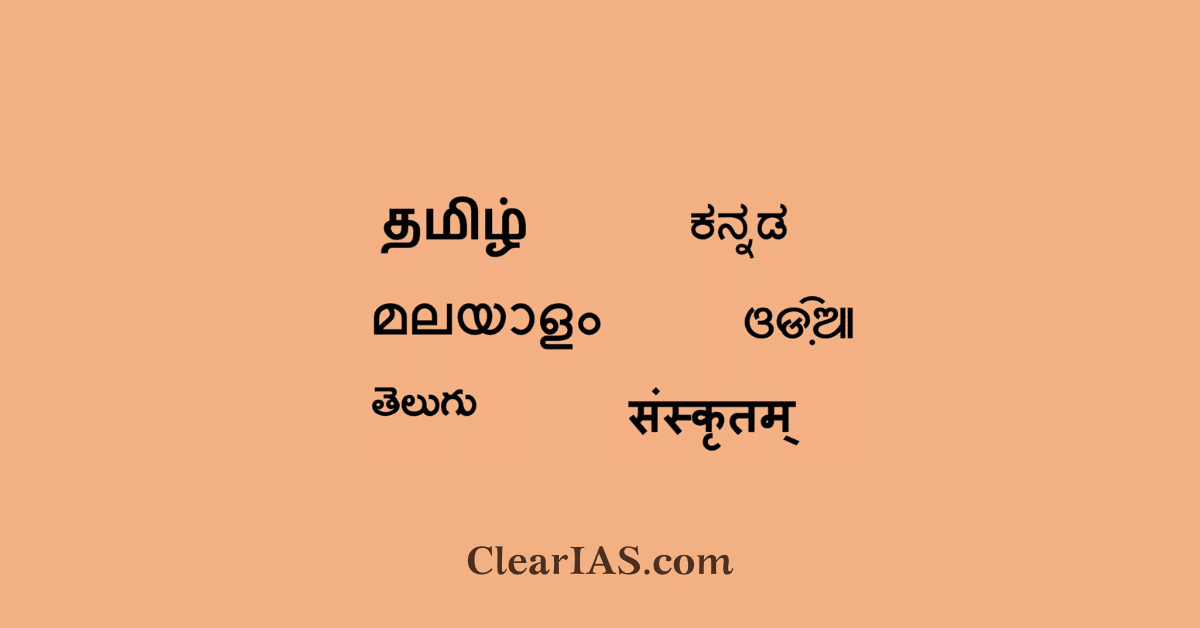
A classical language is one that has a large and lengthy body of written literature, as well as its own literary tradition.
As spoken forms of a language diverge more from the classical written language over time, classical languages often have a high degree of diglossia. In 2004, the Indian government announced that some languages will be referred to as “Classical Languages in India” if they met specific requirements.
What are Classical languages?
Also read: Sanskrit Literature
Classical Languages
These are the literary traditions and large, well-established canons of those languages. They are the languages that have been spoken for a very long time and have further deviated from the traditional written ones.
Also read: Salient Features of Indian Society
Criteria for Declaring a Language as Classical
The Ministry of Culture provides guidelines regarding Classical languages. The Classical Languages in India are listed in the Eighth Schedule of the Constitution. The Rajya Sabha’s Ministry of Culture released the criteria for designating a language as classical in February 2014. Which are:
- History has documented the early texts’ high antiquity.
- A body of old literature or texts that the generation of speakers values as part of their heritage.
- The literary tradition must be unique and unaltered by borrowing from another speech group.
- There may be a gap between the classical languages as well as a difference between classical language and literature.
Benefits Accorded to Classical Languages In India
- For eminent researchers in the classical Indian languages, there are two significant annual international awards offered.
- The establishment of a Center of Excellence for Classical Indian Language Studies.
- A specific number of Professional Chairs for the Classical Languages are to be created by the University Grants Commission (UGC), starting at least in the Central Universities.
Different Classical Languages of India
India has six languages with the designation of “Classical Languages,” including:
Tamil
- In 2004, it was designated as a classical language.
- It is a traditional Dravidian language that is used in Sri Lanka, other Southeast Asian countries, and the Indian state of Tamil Nadu.
- The earliest period of Tamil literature is known as Sangam literature.
- It is one of the 22 languages listed in the Indian Constitution’s eighth schedule.
Also Read: Thiruvalluvar-The great Sangam Poet – ClearIAS
Sanskrit
- In 2005, it was designated as a classical language.
- It belongs to the family of Indo-European languages known as Indo-Aryan.
- It is one of the 22 languages listed in the Indian Constitution’s eighth schedule.
- It speaks in the dialect of traditional Hindu philosophy.
- During the Bronze Age, it spread to the northwest of the subcontinent.
To know more about the Sanskrit language also read Sanskrit Literature – ClearIAS
Kannada
- In 2008, India’s government proclaimed it to be a classical language.
- It is one of the 22 languages listed in the Indian Constitution’s eighth schedule.
- It is a Dravidian language that is used in southwest India and the Indian state of Karnataka.
- It’s written in Kannada, a script that developed from Kadamba in the fifth century.
Telugu
- In 2008, India’s government proclaimed it to be a classical language.
- It is one of the 22 languages listed in the Indian Constitution’s eighth schedule.
- People in the Indian states of Andhra Pradesh and Telangana speak this Dravidian language.
- The proto-Dravidian language, which was spoken in the third century B.C.
Malayalam
- In 2013, India officially recognised it as a classical language.
- It is one of the 22 languages listed in the Indian Constitution’s eighth schedule.
- It is a Dravidian language that is used in Lakshadweep, Puducherry, and Kerala.
- Its earliest literary works are from the ninth to the eleventh centuries.
- The first script used to write Malayalam was Vattezhuthu.
Odia
- It was designated as an Indian classical language in 2014.
- It is one of the 22 languages listed in the Indian Constitution’s eighth schedule.
- In the Indian states of Odisha, West Bengal, Chhattisgarh, and Jharkhand, it is an Indo-Aryan language.
- It has a long literary tradition and less frequently borrows words from other languages.
- The earliest recorded inscription in Odia is from the tenth century CE
Also Read: Ancient Indian Literature – ClearIAS
5 new Classical languages
2024: The Union Cabinet has approved the recognition of five more languages as “classical,” expanding the nation’s list of culturally significant tongues.
- Classical language status has been approved for Marathi, Bengali, Assamese, Pali, and Prakrit.
Marathi
- Origins: Marathi, an Indo-Aryan language, evolved from Maharashtri Prakrit and later Apabhramsha. It became distinct by the 13th century CE.
- Literature and Growth: Marathi literature took off with the Bhakti movement in the 13th century. Early poets like Dnyaneshwar and Tukaram played vital roles in religious and social reform through devotional songs and literature. Under the rule of the Maratha Empire, Marathi was used extensively in administration and cultural life.
- Colonial and Modern Era: With British colonial rule, Marathi developed further with the advent of print culture and education. Today, it is one of India’s major languages, spoken predominantly in Maharashtra.
Pali
- Origins: Pali is a Middle Indo-Aryan language closely related to Sanskrit and Prakrit. It became prominent in ancient India as the language of the Tipitaka, the sacred texts of Theravada Buddhism.
- Role in Buddhism: Pali played a crucial role in spreading Buddhist teachings across Southeast Asia, with texts like the Dhammapada being central to Buddhist philosophy.
- Decline and Revival: Pali declined as a spoken language but remained the liturgical and scholarly language of Theravada Buddhism. Its revival in modern times is primarily through academic studies of Buddhist philosophy and history.
Prakrit
- Origins and Nature: Prakrit refers to a group of Middle Indo-Aryan languages that served as vernacular languages in ancient India, as opposed to the classical language of Sanskrit.
- Significance: Prakrit languages were used in early inscriptions, plays (like those of Kalidasa), and Jain and Buddhist texts. Maharashtri Prakrit, in particular, was the precursor to Marathi.
- Decline: As Sanskrit gained prestige, Prakrit languages began to be associated with folk and local culture. However, they continued to be used in literature and drama into the medieval period.
Assamese
- Origins: Assamese, an eastern Indo-Aryan language, developed from Magadhi Prakrit. It became distinct as early as the 7th century CE.
- Literary Development: The Charyapadas (8th-12th century), a collection of Buddhist mystic songs, are among the earliest forms of Assamese literature. The language flourished during the Ahom dynasty (13th-19th century), with significant contributions from figures like Sankardev, who promoted the Bhakti movement and Assamese culture.
- Colonial and Modern Growth: The advent of print culture during British rule and Assamese’s use as a medium for education solidified its importance. Assamese is now the official language of Assam and an essential part of the region’s identity.
Bengali
- Origins: Bengali evolved from Magadhi Prakrit and Apabhramsha. By the 10th century CE, it had started to develop into a distinct language.
- Cultural and Literary Importance: Bengali literature has a rich tradition, with early texts like Charyapadas. The Bhakti movement also greatly influenced Bengali literature, with poets like Chandidas contributing to its growth. The modern Bengali language and literary canon were shaped during the 19th and 20th centuries, particularly through the Bengal Renaissance and figures like Rabindranath Tagore.
- Present-day Influence: Bengali is one of the most spoken languages in the world and has had a significant impact on literature, cinema, and politics in both India and Bangladesh.
Conclusion
In India, classical languages are acknowledged as having autonomous literature and long-standing customs. They comprise various alterations that have evolved and diverged over centuries. The golden age of literature is characterised by the languages of this time.
Also read:
Article Written By: Atheena Fathima Riyas






Leave a Reply